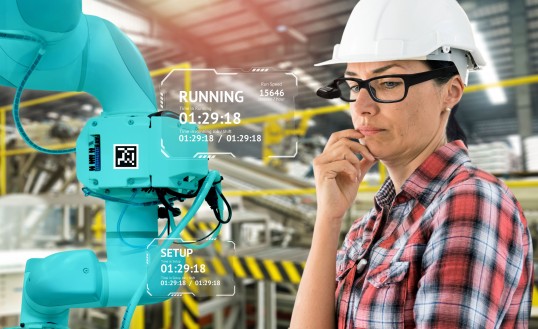- Artificial Intelligence (AI)
- Occupational exposure limit values
- Climate Change and Occupational Safety
- List of CMR substances
- Electromagnetic fields
- Ergonomics
- Industrial Security
- Collaborative robots
- Noise
- Nanoparticles at the workplace
- Optical Radiation
- REACH
- Reference materials
- Proficiency testing
- Vibration
- Virtual reality
- Work 4.0
Smart glasses

Use of smart glasses as assistance systems in industry
Source: zapp2photo - stock.adobe.com
What are smart glasses?
Smart glasses project information directly into the wearer's field of vision, and have the functionality of a smartphone. They are effectively head-mounted micro-computers, and have particular advantages over other mobile devices with similar functionality that are typically used as work tools. Unlike smartphones or tablet PCs, they do not have to be held during use, and they can deliver information to the wearer without the latter having to take their eyes off the work.
Industrial areas of application of smart glasses
Three main application scenarios currently exist for the use of smart glasses as work equipment:
Issues for preventive activity: safe and healthy work with smart glasses
Smart glasses enable workers in certain areas of activity to access relevant information easily whilst at the same time keeping their hands free for other tasks. This reduces the time required to perform certain tasks and increases efficiency compared to work with conventional information systems. At the same time however, smart glasses may present new hazards to workers, which employers must identify and reduce by way of a risk assessment.
From an occupational safety and health perspective, the main aspects to be considered during assessment of jobs involving the use of smart glasses include:
- A possible increase in sensory strain upon the eyes
- Effects on the musculoskeletal system caused by changes in work processes
- Effects of electromagnetic fields
- Rising informational and visual overload
- Mental stress caused by intensification of work and skills shifts
- Mutual influence of the working environment, other work equipment and personal protective equipment (PPE)
Research projects conducted by the IFA on the topic of smart glasses
Smart glasses are a relatively new phenomenon in the world of work, and only limited scientific research on the topic has therefore been conducted to date. Together with accident insurance institutions and external partner organizations, the IFA is conducting joint research projects which have the purpose of obtaining and publishing relevant and up-to-date findings on safe and healthy work involving smart glasses:
Further information

Friemert, D.; Ellegast, R.P.; Hartmann, U.: Data Glasses for Picking Workplaces: Impact on Physical Workloads (payable PDF for download). In: HCI in Business, Government, and Organizations: Information Systems, pp. 281-289. Ed: Springer International, ISBN: 978-3-319-39398-8 (Print), 978-3-319-39399-5 (Online)
Gross, B.; Bretschneider-Hagemes, M.; Stefan, A.; Rissler, J.: Monitors vs. Smart Glasses: A Study on Cognitive Workload of Digital Information Systems on Forklift Trucks (payable PDF for download). In: Digital Human Modeling. Applications in Health, Safety, Ergonomics, and Risk Management. Proceedings. 9th International Conference, DHM 2018, S. 569-578.
Friemert, D.; Terschüren, C.; Gross, B.; Herold, R.; Leuthner, N.; Braun, C.; Hartmann, U.; Harth, V.: What Is the State of Smart Glass Research from an OSH Viewpoint? In: Digital Human Modeling. Applications in Health, Safety, Ergonomics, and Risk Management. Posture, Motion and Health 11th International Conference, DHM 2020, S. 346-364. Proceedings, Part II
Contact
Work Systems of the Future
Tel: +49 30 13001-3040Fax: +49 30 13001-38001

